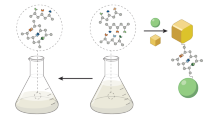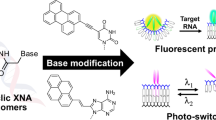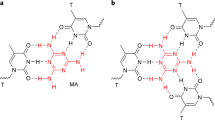Abstract
We describe the synthesis of poly[9,9′-bis(6″-N,N,N-trimethylammonium)hexyl)fluorene-co-alt- 4,7-(2,1,3-benzothiadiazole) dibromide] (PFBT), a cationic, water-soluble conjugated polymer used in label-free DNA microarrays. This polymer was designed to have a maximum absorbance of close to 488 nm, which meets the excitation wavelength of most commercial microarray readers, and to have efficient emission in the solid state. Starting from commercially available chemicals, five steps are required to synthesize PFBT. The first step involves treatment of 2,7-dibromofluorene in 50% potassium hydroxide solution with excess 1,6-dibromohexene at 75 °C for 25 min to afford 2,7-dibromo-9,9-bis(6′-bromohexyl)fluorene (A). In the second step, a mixture of A, bis(pinacolato)diborane and potassium acetate in dioxane is stirred at 85 °C for 12 h to afford bis[9,9′-bis(6″-bromohexyl)-fluorenyl]-4,4,5,5- [1.3.2]dioxaborolane (B). The third step involves bromination of 2,1,3-benzothiadiazole using bromine in the presence of hydrogen bromide to afford 4,7-dibromo-2,1,3-benzothiadiazole (C). Suzuki cross-coupling copolymerization of B and C affords the charge-neutral precursor of PFBT. In the final step, quaternization of pendant groups using trimethylamine yields PFBT. Each step takes up to 3 days, including the time required for product purification. The overall protocol requires approximately 3 weeks.
This is a preview of subscription content, access via your institution
Access options
Subscribe to this journal
Receive 12 print issues and online access
$259.00 per year
only $21.58 per issue
Buy this article
- Purchase on Springer Link
- Instant access to full article PDF
Prices may be subject to local taxes which are calculated during checkout



Similar content being viewed by others
References
Service, R.F. Microchip arrays put DNA on the spot. Science 282, 396–399 (1998).
Southern, E.M. DNA chips: analysing sequence by hybridization to oligonucleotides on a large scale. Trends Genet. 12, 110–115 (1996).
Ramsay, G. DNA chips: state-of-the-art. Nat. Biotechnol. 16, 40–44 (1998).
Epstein, C.B. & Butow, R.A. Microarray technology—enhanced versatility, persistent challenge. Curr. Opin. Biotechnol. 11, 36–41 (2000).
Liu, B. & Bazan, G.C. Methods for strand-specific DNA detection with cationic conjugated polymers suitable for incorporation into DNA chips and microarrays. Proc. Nat Acad. Sci. USA 102, 589–593 (2005).
Liu, B. & Bazan, G.C. Shape adaptable water-soluble conjugated polymers. J. Am. Chem. Soc. 125, 13306–13307 (2003).
Acknowledgements
We are grateful to the National Institutes of Health Grant (GM 62958-01), the NSF (DMR-0097611) and the Institute for Collaborative Biotechnologies for financial support.
Author information
Authors and Affiliations
Corresponding authors
Ethics declarations
Competing interests
The authors decline [or, obviously, “author declines”] to provide information about competing financial interests.
Rights and permissions
About this article
Cite this article
Liu, B., Bazan, G. Synthesis of cationic conjugated polymers for use in label-free DNA microarrays. Nat Protoc 1, 1698–1702 (2006). https://doi.org/10.1038/nprot.2006.272
Published:
Issue Date:
DOI: https://doi.org/10.1038/nprot.2006.272
This article is cited by
-
Synthesis and characterization of polyelectrolytes based on benzotriazole backbone
Colloid and Polymer Science (2018)
-
Star-branched cationic light-emitting dot with silsesquioxane core, synthesis, and light scattering studies
Polymer Bulletin (2012)
-
Single-nucleotide polymorphism (SNP) genotyping using cationic conjugated polymers in homogeneous solution
Nature Protocols (2009)
-
Application of cationic conjugated polymers in microarrays using label-free DNA targets
Nature Protocols (2007)
Comments
By submitting a comment you agree to abide by our Terms and Community Guidelines. If you find something abusive or that does not comply with our terms or guidelines please flag it as inappropriate.



